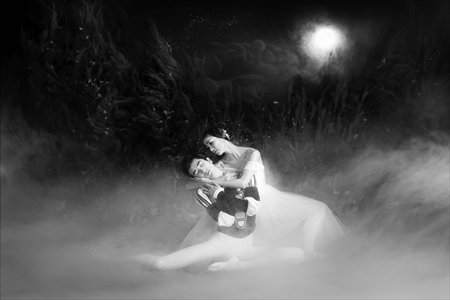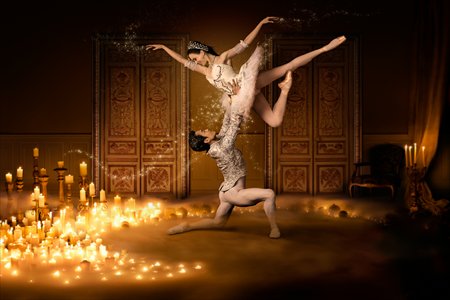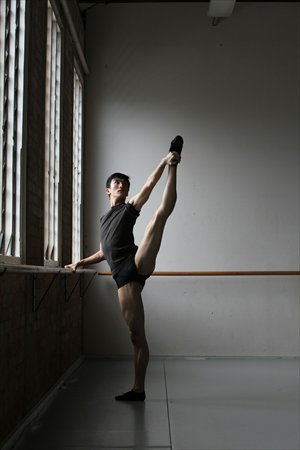Turning En Pointe



When Li Cunxin endured grueling 16-hour days of training as a young boy at the Beijing Dance Academy 40 years ago, it wasn't the thought of an appreciative audience's encore or individual worldwide fame that motivated him. A single image terrorized his mind.
"We heard horror stories in the old times that people would throw rotten tomatoes on stage if they didn't like you. The whole time I danced in China as a student, I was just relieved that there were no rotten tomatoes thrown at me," he laughed.
Plucked as an 11-year-old during the Cultural Revolution (1966-76) from an impoverished village in rural Qingdao, Shandong Province, Li was chosen by a delegation from the dance academy run by Chairman Mao Zedong's wife, Jiang Qing, to study ballet. His childhood quickly pirouetted into an intense training regime that included endlessly practicing turns by candlelight and hopping with heavy sandbags tied to his ankles to build leg strength.
Revolutionary roots
Li graduated as one of China's best dancers, paving the way for him to join the Houston Ballet in a rare cultural exchange program at the time with the US. His remarkable life story, including his dramatic defection and eventual settling in Australia, inspired his bestselling novel Mao's Last Dancer (2003), which was later adapted into a film. Li became a stockbroker after hanging up the ballet shoes, but this year he returned to his cultural roots following his appointment as artistic director of the Queensland Ballet.
Since Li's childhood, ballet in China has come a long way from its Soviet-nurtured origins to find its own place on the world stage. The National Ballet of China (NBC), founded in 1959, relied in its early days on a revolutionary-rich repertoire. In more recent years, it has toured the world performing foreign classics such as Swan Lake, Giselle and Don Quixote to name a few.
Nevertheless, tight controls stifle homegrown creativity.
"Ballet in China still has limitations compared to the West. There are still sensitivities over what kinds of ballets are allowed and care is taken not to upset the political framework," Li told Metro Beijing via Skype from Brisbane, Queensland.
Many of Li's academy classmates from childhood today hold positions of leadership at the NBC. Their challenge looms in striking a balance between ballets that are uniquely Chinese, yet distinctly separate from the Cultural Revolution productions of spinning weaponry and peasantry patriotism.
Stumbling choreography
Li said Zhao Ruheng, a fellow academy alumnus, made a "very bold attempt" to achieve this during her tenure as NBC artistic director from 1994 to 2009 by staging Raise the Red Lantern. Based on the 1991 film of the same name that tells the story of a concubine condemned to death for betraying her master, its ballet adaptation marked a shift in a fresh direction.
"Generally, [Raise the Red Lantern] received praise from critics. It was a step away from the highly political ballets, such as Red Detachment of Women and The White-Haired Girl. Looking back, those ballets were not so good artistically speaking," said Li, a 51-year-old father-of-three.
"But if [the NBC] continues performing Swan Lake or The Sleeping Beauty, they are not uniquely Chinese. In a way, I think what Zhao and [NBC incumbent artistic director] Feng Ying are trying to do is right. But the standard of choreography is letting them down, not the talent of dancers."
Feng declined multiple interview requests by Metro Beijing.
Li boasts three of China's current crop of rising dancers - Yu Hui, Meng Ningning and Hao Bin - in his Queensland company, the latter two who are engaged and, like their teacher, alumni of the Beijing Dance Academy. All are "hungry" to experience new "varieties of choreography and different styles of ballet," Li said.
"I'm excited to help them realize their potential as dancers. They have fantastic training and their technique is strong," he said of the trio, noting he sees "more similarities than differences" between the current generation of Chinese dancers and his.
"I suspect the discipline of my era is slowly disappearing in the current generation. That absolute strictness and pursuit of perfection is really not as evident. I don't think [Chinese] teachers are demanding as much."
Li, who in his novel recalls having his hamstrings torn as a child after being stretched too far, insists "sheer discipline" and the "demand of high standards" should continue to underpin ballet in China.
"Most of my harsh experiences were self-inflicted, so I only have myself to blame. The methods of my teachers - the screaming, the calling of derogatory names - those were unnecessary. Bringing out the best in dancers through positive reinforcement is far more effective than negativity or fear," he said.
Hao, 28, said one of the challenges for him since joining the Queensland Ballet last year has been adapting to the Australian style of "free, open-hearted and passionate" ballet.
"Chinese ballet remains more technique-oriented. It is strict and more by the book, with greater attention paid to detail and less room for interpretation," said principal dancer Hao, who is from Taiyuan, Shanxi Province.
'Lifelong' friendship
It's been more than 30 years since Li's Chinese citizenship was revoked and he was ominously warned by the Chinese consulate-general in Houston he would never return to his homeland.
Time and diplomacy healed old wounds, however, and he now makes an effort to visit China each year to spend Spring Festival with his family in Qingdao or to catch up with his ballet "comrades" in Beijing.
"I love going to Beijing to visit my old academy and see my lifelong friends at the NBC. Beijing has always occupied a special place in my heart," he said. "I'm naturally interested in the development and progress of ballet in China and have always been keen to help if needed."